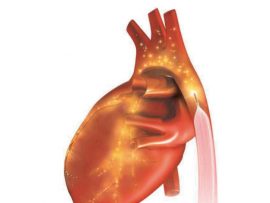Currently, many centers use venovenous extracorporeal membrane oxygenation (VV-ECMO) as an adjunctive means of gas exchange to mechanical ventilation (MV) in patients with severe ARDS and refractory hypoxemia. One of..
Read MoreMechanical ventilation (MV) is a crucial element in the management of acute respiratory distress syndrome (ARDS), because there is high level evidence that a low tidal volume of 6ml/kg (protective..
Read MoreObjective Cerebral autoregulation (CA) impairment may pose a risk factor for neurological complications among children supported by extracorporeal membrane oxygenation (ECMO). Our first objective was to investigate the feasibility of..
Read MoreSevere respiratory syndrome coronavirus-2 is responsible for coronavirus disease 2019 (COVID-19), which may lead to acute respiratory failure. In its most severe manifestation including refractory hypoxemia and/or hypercapnia, it can..
Read MoreAbstract The role of extracorporeal membrane oxygenation (ECMO) in the management of critically ill COVID-19 patients remains unclear. Our study aims to analyze the outcomes and risk factors from patients..
Read MoreThe Coronavirus Disease 2019 (COVID-19) pandemic has required rapid and effective protocol adjustments at every level of healthcare. The use of extracorporeal membrane oxygenation (ECMO) is pivotal to COVID-19 treatment..
Read MoreBackground Extracorporeally induced whole‐body hyperthermia (eWBH) might be a beneficial treatment in cancer patients. Objectives of this pig study were to assess thermal distribution, (patho‐)physiological effects, and safety of eWBH..
Read MoreAbstract Purpose Emerging evidence suggests that hyperthermic intraperitoneal chemotherapy (HIPEC) with cytoreductive surgery (CRS) shows a survival benefit over CRS alone for patients with epithelial ovarian carcinoma (EOC). This systematic..
Read Morefecha mision: ++++++++++ objetivo de la mision: ++++++++ Contacto: ++++++++++ link pagina
Read MoreAbstract Background The role of vascular endothelial growth factor (VEGF)-induced 3 different nitric oxide synthase (NOS) isoforms in lung development and injury in the newborn (NB) lung are not known...
Read MoreAbstract Background After cardiac surgery, postoperative delirium (POD) is common and is associated with long-term changes in cognitive function. Impact on health-related quality of life (QOL) and long-term dependence are..
Read MoreThe data article refers to the paper titles “Impact of malnutrition on long-term survival in adult patients after elective cardiac surgery” . The data refer to the analysis of the relationship..
Read MoreAbstract Extracorporeal CO2 removal is a highly promising support therapy for patients with hypercapnic respiratory failure but whose clinical implementation and patient benefit is hampered by high cost and highly specialized..
Read MoreAbstract A Caucasian male with known severe aortic stenosis was referred to our Ophthalmology Department after undergoing cardiac surgery using extracorporeal circulation. Signs of retinal ischaemia were found during fundus..
Read MoreAbstract Introduction: Pediatric cardiac Extracorporeal Membrane Oxygenation (ECMO) is effective, however, bleeding and clotting issues continue to cause significant morbidity and mortality. The objective of this study was to assess..
Read MoreAbstract This practical guidance, endorsed by the Brazilian Society of Thrombosis and Hemostasis and The Brazilian Society of Angiology and Vascular Surgery, the International Union of Angiology and the European..
Read MoreAbstract Weaning failure and mortality rates in veno-arterial extracorporeal membrane oxygenation (VA-ECMO) supported patients are significant. Small studies suggest the possible usefulness of levosimendan in this environment, especially in postcardiotomy..
Read MoreTraditionally, ABO-incompatible heart transplantation was accomplished using a plasma exchange technique to remove recipient plasma containing donor-incompatible anti-A/B isohaemagglutinins. However, this technique exposed patients to large volumes of allogeneic blood..
Read MoreLos catéteres más pequeños son mejores para el paciente, ya que reducen las posibles complicaciones vasculares. Sensation 7 Fr. es el catéter BIA más pequeño disponible en la actualidad. Gracias..
Read MoreAbstract In cardiac surgical patients, tranexamic acid (TXA) has been associated with an increased risk of convulsive seizure (CS). We aimed to investigate whether in patients undergoing isolated coronary artery..
Read MoreAbstract Extracorporeal membrane oxygenation (ECMO) is inevitable external life support in case of cardiac and respiratory failure since the 1970s. Acute kidney injury (AKI) and the requirement of renal replacement..
Read MoreAbstract A morbidly obese middle aged woman in her 40's presented to another hospital with and subsequently developed severe . Her oxygenation demonstrated no improvement with low ventilation, paralysis, or prostagladin therapy. She..
Read MoreAbstract Lung transplantation may be a final destination therapy in lung failure, but limited donor organ availability creates a need for alternative management, including artificial lung technology. This invited review..
Read MoreAbstract During cardiopulmonary bypass (CPB), platelet activation and dysfunction are associated with adverse outcomes. Remote ischemic preconditioning (RIPC) has been shown to attenuate platelet activation. We evaluated the effects of..
Read MoreImpact of Corticosteroids on Cardiopulmonary Bypass Induced Inflammation in Children:A Meta-Analysis
Abstract Background Corticosteroids (CS) suppress the inflammatory response to cardiopulmonary bypass in children undergoing cardiac surgery. What is less clear is the impact of CS on the postoperative course. Methods..
Read MoreBackground It is unclear whether high-dose regimens of tranexamic acid in cardiac surgery (total dose, 80 to 100 mg/kg) confer a clinical advantage over low-dose regimens (total dose, approximately 20..
Read MoreIn 2002, Cribier et al. reported the first percutaneous transcatheter aortic valve replacement (TAVR) in a human subject. In this landmark manuscript, the authors described each step of the procedure..
Read MoreBackground Although corticosteroid prophylaxis in adult cardiac surgery has been studied extensively for 40 years, its role remains controversial, and the optimal dose remains uncertain. The objective of this meta-analysis..
Read MoreAbstract Platelet Mapping can measure both the degree of platelet inhibition and fibrinogen activation, was not originally designed to measure fibrinogen concentration. Traditional laboratory fibrinogen concentration testing requires around 60..
Read MoreAbstract Since the beginning of the pandemic Coronavirus Disease 2019 (COVID-19), calls were made for informed allocation of costly, limited health care resources such as extracorporeal membrane oxygenation (ECMO). At..
Read More
















